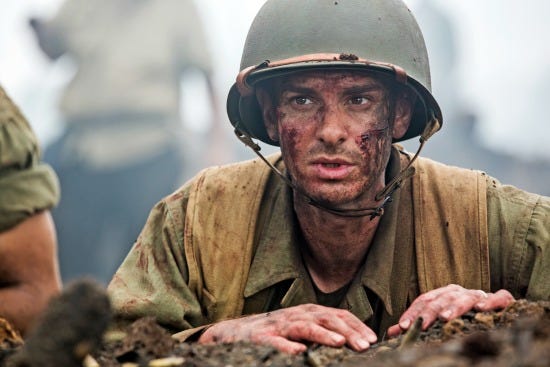Hacksaw Ridge

Though it’s a little too self-serious, and emphasizes the devastation of war to the extent it overshadows the grace of its pacifist subject, “Hacksaw Ridge” has immense and undeniable power. It’s a World War II drama about a man who refused to fight because of his religious beliefs, but whose heroism in combat earned him the Congressional Medal of Honor.
Andrew Garfield plays Desmond Doss, a humble kid from backwater Virginia who enlisted in the Army after Pearl Harbor despite having vowed never to kill, or even touch a gun. Part of that comes from his faith, being a Seventh-day Adventist, but also having grown up to an abusive father (Hugo Weaving) who continually threatened him, his mother (Rachel Griffiths) and brother.
Garfield breathes life into what could have been one-note character, helped by a nuanced screenplay by Andrew Knight and Robert Schenkkan (based on a book by Booton Herndon). He plays Doss as a man of tremendous conviction but little personal pride. His obstinacy in the face of officers threatening to court-martial him for refusing orders comes from the knowledge that he couldn’t live with himself having betrayed his beliefs.
I am certain Garfield's name will get tossed around during the awards season. It deserves to be.
“Hacksaw” is being widely touted as Mel Gibson’s comeback. It’s been 10 years since he last directed a film (“Apocalypto”) after the gargantuan phenomenon of “The Passion of the Christ,” and the even larger impact of his hateful statements following a drunk-driving arrest.
As before, his filmmaking style is brash, energetic, unsubtle. If filmmakers could be classified by musical genre, Gibson falls closely to Oliver Stone: hard rock with lots of power chords and screaming guitar solos. After a while it can be overwhelming, but it’s hard to refute that his films thrum their way into your chest.
The combat section, which take up the second half of the film, is a belching apocalypse of smoke and fire, blood and torn bodies. Gibson’s camera lingers over pieces of men strewn across the titular ridge of Okinawa, which the Japanese fought to their last breath to keep in the closing days of the Pacific campaign.
He turns to slow motion again and again (and again), mesmerized by the ballet of death. As we know from “Christ,” Gibson has his fixation with the ravages of the flesh.
It gives the war sequence its verve, but also distracts too much from the plight of Doss. He flits from wounded man to wounded man, providing drugs, bandages, tourniquets. Only after the fighting has calmed and the Americans have fled does his true bravery emerge, and it’s by far the film’s shining apex.
It’s notable that Gibson, having spent his long career playing and directing men of violence, has presented us with a pacifist as his newest hero.
The other soldiers are given broad strokes, set apart by a few personality or physical traits to make them distinguishable. Luke Bracey impresses as Idiot, a hard-charging natural fighter who transforms from Doss’ chief bully to fiercest protector. Vince Vaughn brings comic notes to the role of the hardcase sergeant, and Sam Worthington plays the resolute captain who must deal with a very unique recruit.
The first half of the movie is a study in contrasts, a languid exploration of Doss’ early life, romance with a young nurse played by Teresa Palmer, conflict with his dad (a traumatized WWI vet) over enlisting and his tough go during basic training, where he is branded a coward. It works, but only because we know where it’s all heading.
As I was preparing to write this review, I was surprised to see “Hacksaw Ridge” described as a Christian film. It’s understandable, since “Christ” became a hit largely through underground screenings for church groups, and it gave faith-based moviemaking a jolt that continues today.
But I disagree with applying that label here. This is a movie about an exceptional Christian. It does not try to proselytize to the audience, but simply show Desmond Doss for who he was: a man of resounding faith who saw a world pulling itself and felt compelled to bind the wound.



